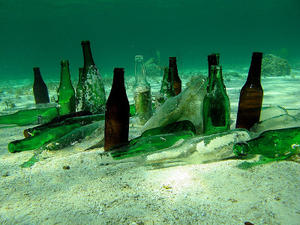WaterWaste glass cleans up water
A simple method converts waste glass into a material which can be used to remove pollutants from contaminated water; the method uses colored glass which is being stockpiled in the United Kingdom as there is less recycling demand for green and brown bottles than there is for clear bottles

These bottles, converted into torbermorite, remove contaminants // Source: grist.org
A simple method to convert waste glass into a material which can be used to remove pollutants from contaminated water has been developed by Dr. Nichola Coleman from the University of Greenwich’s School of Science.
Nichola Coleman, a Senior Lecturer in Materials Chemistry at the university’s Medway campus, says: “The novelty of the research is that the glass can be recycled into something useful – nobody has previously thought to use waste glass in this way.”
A University of Greenwich release reports that she is finding a new use for the large quantities of colored glass which are being stockpiled in the United Kingdom as there is less recycling demand for green and brown bottles than there is for clear bottles.
Her simple processing method creates tobermorite, a naturally occurring mineral, by combining waste glass with other basic materials.
A mixture of ground glass, lime, and caustic soda is heated to 100 Celsius in a sealed stainless steel container to produce the tobermorite. The mineral, which can be produced as a powder or granules, can be used to absorb toxic heavy metals from water located beneath the ground or waste water streams.
Nichola is now looking at creating other types of filter and forming barriers that could prevent pollutants spreading from contaminated areas.
— Read more in N. J. Coleman, “A tobermorite ion exchanger from recycled container glass,” International Journal of Environment and Waste Management 8, nos. 3-4 (2011): 366-82
